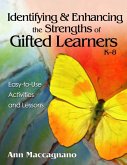- Broschiertes Buch
- Merkliste
- Auf die Merkliste
- Bewerten Bewerten
- Teilen
- Produkt teilen
- Produkterinnerung
- Produkterinnerung
This collection of 63 instructional strategies for teaching diverse secondary students includes teacher feedback, literature resources, and information for choosing appropriate strategies.
Andere Kunden interessierten sich auch für
![63 Tactics for Teaching Diverse Learners, K-6 63 Tactics for Teaching Diverse Learners, K-6]() Bob Algozzine63 Tactics for Teaching Diverse Learners, K-635,99 €
Bob Algozzine63 Tactics for Teaching Diverse Learners, K-635,99 €![Academic Language in Diverse Classrooms Academic Language in Diverse Classrooms]() Margo GottliebAcademic Language in Diverse Classrooms28,99 €
Margo GottliebAcademic Language in Diverse Classrooms28,99 €![Identifying and Enhancing the Strengths of Gifted Learners, K-8 Identifying and Enhancing the Strengths of Gifted Learners, K-8]() Ann MaccagnanoIdentifying and Enhancing the Strengths of Gifted Learners, K-835,99 €
Ann MaccagnanoIdentifying and Enhancing the Strengths of Gifted Learners, K-835,99 €![Teaching and Learning in Diverse Classrooms Teaching and Learning in Diverse Classrooms]() Carmelita Rosie CastañedaTeaching and Learning in Diverse Classrooms69,99 €
Carmelita Rosie CastañedaTeaching and Learning in Diverse Classrooms69,99 €![Enhancing Teaching in Diverse Classrooms Enhancing Teaching in Diverse Classrooms]() Richard A. VasquezEnhancing Teaching in Diverse Classrooms18,99 €
Richard A. VasquezEnhancing Teaching in Diverse Classrooms18,99 €![Reaching and Teaching Diverse Populations Reaching and Teaching Diverse Populations]() Mary Bellucci BuckelewReaching and Teaching Diverse Populations95,99 €
Mary Bellucci BuckelewReaching and Teaching Diverse Populations95,99 €![Diversity Teacher (survival guide for teaching in a diverse classroom) Diversity Teacher (survival guide for teaching in a diverse classroom)]() D. M. Vanessa P. GirardDiversity Teacher (survival guide for teaching in a diverse classroom)105,99 €
D. M. Vanessa P. GirardDiversity Teacher (survival guide for teaching in a diverse classroom)105,99 €-
-
-
This collection of 63 instructional strategies for teaching diverse secondary students includes teacher feedback, literature resources, and information for choosing appropriate strategies.
Produktdetails
- Produktdetails
- Verlag: Corwin
- Seitenzahl: 200
- Erscheinungstermin: 17. März 2009
- Englisch
- Abmessung: 280mm x 216mm x 11mm
- Gewicht: 518g
- ISBN-13: 9781412942423
- ISBN-10: 141294242X
- Artikelnr.: 26017490
- Herstellerkennzeichnung
- Libri GmbH
- Europaallee 1
- 36244 Bad Hersfeld
- gpsr@libri.de
- Verlag: Corwin
- Seitenzahl: 200
- Erscheinungstermin: 17. März 2009
- Englisch
- Abmessung: 280mm x 216mm x 11mm
- Gewicht: 518g
- ISBN-13: 9781412942423
- ISBN-10: 141294242X
- Artikelnr.: 26017490
- Herstellerkennzeichnung
- Libri GmbH
- Europaallee 1
- 36244 Bad Hersfeld
- gpsr@libri.de
Bob Algozzine is a professor in the Department of Educational Leadership at the University of North Carolina and project codirector of the U.S. Department of Education-supported Behavior and Reading Improvement Center. With 25 years of research experience and extensive firsthand knowledge of teaching students classified as seriously emotionally disturbed, Algozzine is a uniquely qualified staff developer, conference speaker, and teacher of behavior management and effective teaching courses. He is active in special education practice as a partner and collaborator with professionals in the Charlotte-Mecklenburg schools in North Carolina and as an editor of several journals focused on special education. Algozzine has written more than 250 manuscripts on special education topics, including many books and textbooks on how to manage emotional and social behavior problems.
Preface
Acknowledgments
About the Authors
Part I. Planning Instruction
1. Decide What to Teach
2. Decide How to Teach
3. Communicate Realistic Expectations
Part II. Managing Instruction
4. Prepare for Instruction
5. Use Time Productively
6. Establish Positive Environments
Part III. Delivering Instruction
7. Present Information
8. Monitor Presentations
9. Adjust Presentations
Part IV. Evaluating Instruction
10. Monitor Student Understanding
11. Monitor Engaged Time
12. Keep Records of Student Progress
13. Use Data to Make Decisions
References
Additional Readings
Index
Acknowledgments
About the Authors
Part I. Planning Instruction
1. Decide What to Teach
2. Decide How to Teach
3. Communicate Realistic Expectations
Part II. Managing Instruction
4. Prepare for Instruction
5. Use Time Productively
6. Establish Positive Environments
Part III. Delivering Instruction
7. Present Information
8. Monitor Presentations
9. Adjust Presentations
Part IV. Evaluating Instruction
10. Monitor Student Understanding
11. Monitor Engaged Time
12. Keep Records of Student Progress
13. Use Data to Make Decisions
References
Additional Readings
Index
Preface
Acknowledgments
About the Authors
Part I. Planning Instruction
1. Decide What to Teach
2. Decide How to Teach
3. Communicate Realistic Expectations
Part II. Managing Instruction
4. Prepare for Instruction
5. Use Time Productively
6. Establish Positive Environments
Part III. Delivering Instruction
7. Present Information
8. Monitor Presentations
9. Adjust Presentations
Part IV. Evaluating Instruction
10. Monitor Student Understanding
11. Monitor Engaged Time
12. Keep Records of Student Progress
13. Use Data to Make Decisions
References
Additional Readings
Index
Acknowledgments
About the Authors
Part I. Planning Instruction
1. Decide What to Teach
2. Decide How to Teach
3. Communicate Realistic Expectations
Part II. Managing Instruction
4. Prepare for Instruction
5. Use Time Productively
6. Establish Positive Environments
Part III. Delivering Instruction
7. Present Information
8. Monitor Presentations
9. Adjust Presentations
Part IV. Evaluating Instruction
10. Monitor Student Understanding
11. Monitor Engaged Time
12. Keep Records of Student Progress
13. Use Data to Make Decisions
References
Additional Readings
Index









